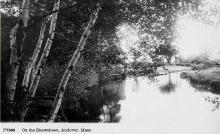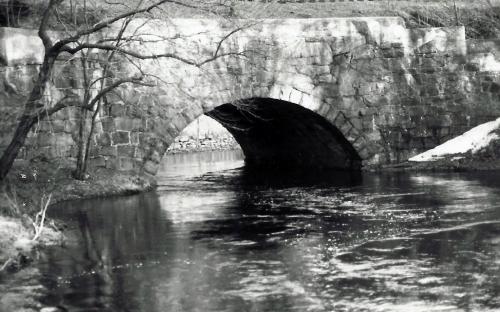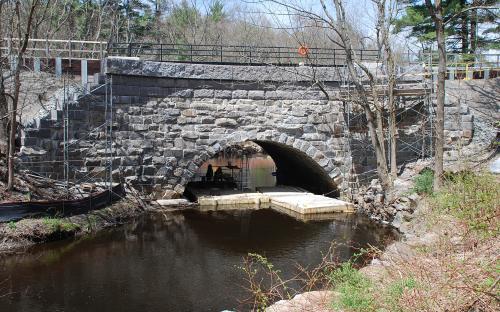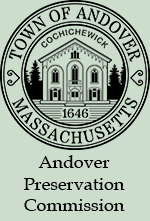Architectural Description:
Natural setting on the Shawsheen River with view of stone arch rail road bridge constructed about 1848 and listed on the National Register of Historic Places
Historical Narrative:
The current AVIS Lupine Reservation on the north west corner of Lupine Road and Central Street was once a meadow owned by James Abbott and then his son Hartwell B. Abbott of 5 Andover Street. In July 1878 Hartwell sold this 1 acre 99 rods parcel of land to his newlywed daughter Elizabeth Punchard (Abbott) Pratt, wife of Thomas Franklin Pratt for $1 and other valuable considerations. Elizabeth & T. Frank Pratt built their home at 105 Central Street. Lupin Rd, now spelled Lupine, was originally called Rail Road Street which extended from Main St. near the "Whole Foods Market" the turned over the railroad crossing at Essex St. and continued parallel to the tracks ending at Central St. The road was extended from School St. to Central about 1880 when the Andover Electric Co. located their building there. The street name was changed on request of the abutters to Lupin Road by Town Meeting vote in 1911. Perhaps taken from the name of Horace Hale Smith's property map name "Luipin Hill".
T. Frank Pratt died on November 25, 1908. His wife Elizabeth remained in her home but began selling off parcels of land along Lupine Road. It appears likely that the Pratt family may have built a small boat house on the river for their own use as many residents have mentioned privately owned boat houses along the river from Ballardvale to Abbott Village.
Elizabeth sold a large lot of land behind her house that extended across the road and down to the river. It was purchased by Horace Hale Smith on August 2, 1910. Smith was a Civil Engineer and architect with his office in the Bay State Building in Lawrence. He and his wife Bessie C. were living in Reading at the time he purchased the property from Mrs. Pratt. A map of his land (#72) called "Lupin Hill" Aug. 2, 1910, clearly shows his house at #54 Lupine Rd and the boathouse and ramp across the street. Smith was an avid outdoors man, enjoyed boating, fishing and hunting. Smith was one of the founders of the Andover Canoe Club and establish a clubhouse and a boathouse on the river at this location.
Andover Canoe Club
The canoe club’s first boat house was located just north of the Hartwell Abbott Bridge (formerly known as James Abbott Bridge) on Central St. on the lower flat meadow next to the river. Built on stone piers the building was for canoe storage and measured approximately 20’ x 30’ with a wooden boat ramp down to the river edge. The boat house had been quickly built according to John Broderick, with a gable roof and wide doors giving entry to as many as 16 canoe racks inside. Access to the site was a set of stairs and a ramp that ran down the embankment from Lupine Road.
Horace Hale Smith also seems to be the driving force in establishing a boat rental facility and canoe club at this site. Smith designed and built for himself the fine Prairie Craftsman style home of stucco at #54, on the hillside opposite the flats with a grand view of the river and the great arched railroad bridge over the Shawsheen River.
Andover Townsman (AT) August 19, 1910 pg. 1 The Shop on Railroad Street (Lupine Road) which was built a few years ago for the manufacture of rubber goods, has been purchased by Horace H. Smith, the well known Lawrence civil engineer, and the property is new [sic. now] being converted into a boat-house and garage. [#50 Lupine Rd.]
Horace Smith lived at Lupine Road for 10 years. He transferred the property over to his wife Bessie C. in 1911. They sold the canoe house, "also 16 canoes, paddles and other fittings now or in the canoe house on said land." to Kenneth C. Foster on March. 26, 1919 and the small piece of the lot under it. Kenneth Foster continued renting boats but sold to Harry Sellers in Aug. 11, 1921. Sellers held the property for 40 years before selling it to AVIS in April 1961. This would be the first parcel acquired on this site by AVIS, lot #55.
Horace & Bessie Smith retired to Ft. Lauderdale, Florida and sold their house and remaining river front lot to Charles E. & Blanche Foster on Oct. 28, 1920. Bessie however held on to the club house lot at #50. Perhaps used by the Hales as a summer camp until 1938 when they sold to Christopher & Helen Muller. See corrected Map #401 of Lupin Hill - 1920.
Elizabeth Pratt sold off a second lot at #57 Lupine Rd. on June 17, 1927 to Joanna C. Guthrie later to become Mrs. Harry Freeman. Their lot also extended down to the river. Freeman sold to Walter & F. & Hazel Muller in Dec. 1941. The property then went to Clinton E. & Barbara Barbero in Sept. 1950. They held for 6 years selling to John & Ruth M. MacDougall in Oct. 1956. The MacDougalls deeded their river lot property #57 to AVIS in November 1970.
When Elizabeth Pratt died in January 1934 the estate went to her heirs and later the Andover Savings Bank took possession of the house in 1938. (#105 Central St.) The bank sold the property to Albert & Jennie Kerr in in 1947. Later George & Mary Stewart owned in 1958 who then sell to John C. & Carol Fisher in June 1960. Carol Fisher died and John remarried. John & Samia K. Fisher sold their river lot #59 to AVIS on Dec. 30, 1969.
The final river lot was deeded to AVIS by William Hatch of in Nov. 1983. Hatch transferred #54 Lupine Road to his daughter Sally at the same time, the former Horace Hale House.
Additional Notes on the site;
1913 Andover Canoe Club Pomp’s Canal ½ mile long
Andover Townsman, November 28, 1913 - Andover Canoe club is just completing an addition to its clubhouse which will accommodate 24 additional canoes & also include a hall to be used for social purposes. 35 canoes are now enrolled in the club.
1915 - Map of Shawsheen River 1915. BALLARD LINE – Most picturesque scenic excursion in eastern Massachusetts. Map created by Horace Hale Smith & F. Homer Foster – Engineers – 1915 Andover Canoe Club.
The map begins at the bridge on Essex Street at Shawsheen and Red Spring Roads just north of the Smith and Dove Manufacturing Company dam and continues south up river to the Ballardvale Mill dam near Andover Street in Ballardvale Center. It was later used for the work in creating a State Game Sanctuary on the Shawsheen River of which much is now in the holdings of AVIS. (Andover Village Improvement Society)
April 30, 1915 – Hearing on a Game Sanctuary – secretary of the State Game Commission.
February 15, 1916 AT – Work on Game Sanctuary
Andover Townsman – April 28, 1916 pg 4 - Canoe Club Notes
The Andover Canoe Club is now enrolled in the American Canoe Association, an organization which includes clubs of this nature all over America. It is a strong organization and the local members no doubt will derive some benefits from the affiliation.
Tomorrow evening, April 29, at 8 o’clock, the election of officers will take place and the program of the season will be announced. Refreshments will be served.
At this meeting a travelogue will be given by E. H. Van Nortwick, on canoe cruising in New Jersey. You are welcome whether you belong or whether you may or may not want to join. Come and get a glad hand from Clarence H. Weeks, commodore; F. Homer Foster, secretary, and Horace Hale Smith, chairman House Committee.
Andover Townsman – May 5, 1916 pg. 4 - Canoe Club Election
The annual meeting and housewarming of the Andover Canoe club was held in the clubhouse last Saturday evening with a large attendance of members and friends. The officers elected for the ensuing year were as follows: Commodore, John Erving; vice commodore, John A. Burtt; captain George W. Donovan; first lieutenant, George Symonds; second lieutenant, John Dugan; secretary, F. Homer Foster; treasurer, James Nicoll; chairman house committee, Horace Hale Smith; steward, Richard Major.
It was voted to hold the annual regatta at Pomp’s pond on July 4, and it was also voted to repair the canal from the Shawsheen to Pomp’s pond. The reports of the various officers for the past year showed and excellent condition of the club and a successful season is looked forward to. The officers will hold a meeting later and issue announcements as to the summer events. Refreshments were served during the evening.
An interesting travelogue on “Canoe Cruising in New Jersey” was given by E. H. Van Nortick and P. W. Partridge gave a talk in reference to the Grand Banks Cruising.
This was one of the most enthusiastic meetings ever held. This club is the largest canoe club north of the Charles River. There are fifty canoes in the house at the present time and more will be added this year. The Andover Canoe Club is enrolled in the American Canoe Association.
June 16, 1916 - AT – pg. 1, Launching of the “William Ballard” an excursion boat on the Shawsheen River between Abbott Village and Ballardvale.
June 30, 1916 pg.1, Launching of the “William Ballard” the boat on the Shawsheen River on Sat. July 1.
July 7, 1916 AT -pg. 8 William Ballard launched.
The new motor yacht, WILLIAM BALLARD, of the Ballard Line is built in a very unique manner, resting almost on the surface of the river, requiring but ten inches of water when all thirty passengers are on board…The Andover Canoe Club Livery Canoes are built to a special design which is both safe and fast, being particularly adapted to our beautiful stream.
These Kennebec canoes may be rented at 50¢ for five hours any time except Sunday 2 to 5 and holidays when triple the rate is charged. For timid, we have an absolutely safe row boat.
Aug. 4, 1916 pg. 5 - 4th Canoe Club Regatta on the Shawsheen River
November 10, 1916 Map of State Reservation drawn by William H. Foster (Forster was Andover native, commercial artist, designer of the Andover Town Seal, Fist Illustrated LL Bean catalog cover, co-inventor of Skeet Shooting, Editor of Outdoors-men Magazine)
AHS achieves pg. 105 folder 2 MS s 339.
Andover Townsman – June 28, 1918 - Canoe Club Meeting.
The Andover Canoe Club held its monthly meeting Monday evening at the clubhouse, with a large attendance. Plans for the regatta which is held yearly at Pomp’s Pond were completed. In spite of the fact that many of the most active members are with the colors, this will be one of the best events. Commodore Burtt and Captain Bateson have arranged a splendid program.
It was decided to build a new dam at the river end of Pomp’s Pond canal. This structure will be of concrete and much more convenient than the present wooden one.
The club has a good membership list and an enthusiastic set of officers who are working to reach high-water mark with every event on this year’s calendar.
Interviews of town residents.
Mr. Jim Trott, who grew up at 85 Central Street, states in an article in the Townsman October 19, 2006 by Bill Dalton, that “Abbot Academy …maintained a boathouse on the Shawsheen River. It disappeared sometime in the ‘30s …inside it were racks with 8 to 12 canoes resting upside down. These canoes were available to the general public for a fee, and many times my father would rent one and load up such members of the family that wanted to paddle off. I think we always went up river. Not to far down the river you came to Frye (Abbot) Village and a dam, which furnished power for a textile mill. So we went up the river, never to Ballardvale, but always taking a tributary stream that got very narrow, usually requiring some portage, and finally took you to Pomp’s Pond… We would picnic on the shores, roam the woods and return home late in the day. It was good for the soul. One of the best parts was dragging your hands in the cool water, from the canoe, on a hot summer day, snagging water lilies and cowslips as you went. Father and sons would fish sometimes and come up with a small sunfish or perch or – great day! – a pickerel. I remember one time, while we were threading the stream flowing from Pomp’s Pond, seeing a long black snake looped along the streamside bushes.”
On September 18, 1998 Dick Eldred and Jim Batchelder taped an interview with John Broderick at the Eldred home at 50 Lupine Rd. about his memories of life on the river in the - John was born in 1915, lived in Abbot Village, and was referred to as the “River Man” by locals. John spent nearly his entire life boating on the Shawsheen River. He remembers “the boathouse as a large one story, barn like shanty not well constructed or maintained. It sat on piers and had a ramp that extended into the water. An excursion boat tided up to it and ran tours up and down the river. It was a wide low boat with about a three foot clearance between the water and the bridge.”
When he was a teenager he built a kayak and later bought a canoe from Mr. William Clark at 51 Red Spring Rd. “It had been in the cellar of the barn, sitting on sawhorses so long that both ends had rotted out”. John, a carpenter, repaired the canoe and replaced the canvas covering. He kept his boats at Mr. James Levis’ house at 78 Red Spring Rd. as did many other local residents. “Canoes were the sports cars in those days and most families owned one. Nobody wanted to put a canoe in and take it out, so they stored them here. The Valentine’s had a boathouse on the mill pond and had a rowing canoe.” (Their boathouse was later moved to the Valentine property at 53 Red Spring Rd. and converted into a garage.) “The mill pond today is just a field with a cut through it. It was eight or nine feet high and you could just glide through. The Smith and Dove Co. kept the dam up for steam to operate the mill. The steam building was next to the metal bridge below the dam. The river was three or four feet higher all the way to Ballardvale before they, Rockwell, took the dam out and destroyed the river."
"I used to trap muskrats and mink along the river. I remember the canoe canal cut by hand by two guys into Pomp’s Pond so boaters could make a round trip of the river up stream through Pomps and out the canal. At the south outlet of the pond was a sandy area called Bullard’s meadow. They planted celery there.” There is a dyke across the outlet toady to keep the water level up.” John B. and friend John Higgins built a dugout canoe. “The town was cutting trees near the tennis court and the sandpit and we got a 14’ long tree log and made it into a dugout. Indians used to burn them out. Some years ago some kids found it and contacted the Peabody Archeology Museum at Phillips Academy. They all thought it was an ancient relic. I think it is now at the Children’s Museum.”
Bibliography/References:
James Abbott estate.
Hartwell B. Abbott
Elizabeth P. (Abbott) Pratt - June 26, 1878 - b. 51 p. 551 the river meadow lot - #55 - #57 & #59
Parcel B. & C - Horace Hale Smith lot - #54 and #50 Lupine - Aug. 2, 1910 - b. 293 p. 375
Parcel A - Joanna C. (Guthrie) Freeman - #56 and #57 - June 17, 1927 - b. 533 p. 350
Harry Sellers - Aug. 11, 1921 - b. 444 p. 346
AVIS - Apr. 18, 1961 - b. 934 p. 372 - lot #55
John C. & Samia K. Fisher - May 30, 1969 - b. 1133 p. 122
AVIS - Dec. 30, 1969 - b. 1146 p. 301 lot #59
John L. & Ruth M. MacDougall - Oct. 13, 1956 - b. 845 p. 68
AVIS - Nov. 13, 1970 - b. 1162 p. 282 lot #57
William G. Hatch and Sally Hatch - Dec. 15, 1948 - b. 719 p. 14 #54 portion river lot.
AVIS - Dec 13, 1983 - b. 1756, p 256
Inventory Data:
| Street | Lupine Rd |
| Place | Andover Center |
| Historic District | Not Applicable |
| Historic Name | AVIS Lupine Reservation - Andover Canoe Club boat house |
| Present Use | Conservation land |
| Original Use | farm meadow - boat launching area |
| Construction Date | about 1910 |
| Source | ERDS, ENRDL |
| Major Alterations | Andover Canoe Club Boathouse razed |
| Demolished? | Yes |
| Demolition Details | 1940's |
| Acreage | 3 acres |
| Setting | Conservation land on river |
| Map and parcel | 74-36 |
| Recorded by | James S. Batchelder |
| Organization | Andover Preservation Commission |
| Date entered | March 29, 2014 |









